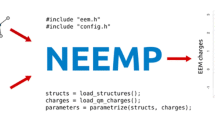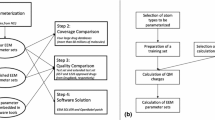Abstract
Charge sensitivity analysis (CSA) was extended to AMBER force-field resolution. The effective electronegativity and hardness data were found using evolutionary algorithms. Four model hardness matrices based on the classical electrostatic, Mataga–Nishimoto, Ohno, and Louwen–Vogt interpolation formulae were considered. Mulliken population analysis and electrostatically derived charges (CHELPG) were taken into account. It was demonstrated that the Ohno interpolation formula gives the best fit to Mulliken charges. For all molecules from the training set and all model hardness matrices, Mulliken charges were reproduced more accurately than CHELPG charges, indicating their good transferability from system to system. The effective electronegativities and hardnesses obtained were further verified by applying CSA to molecules from a validation set that was different from the training set. The correlation between CSA and Mulliken charges was of the same quality as that obtained for the training set.



Similar content being viewed by others
References
Mulliken RS (1955) Electronic polulation analisys on LCAOMO molecular wave functions I. J Chem Phys 23:1833–1841
Löwdin PO (1950) On the non-orthogonality problem connected with the use of atomic wave functions in the theory of molecules and crystals. J Chem Phys 18:365–376
Roby KR (1974) Definition of the charge on an atom in a molecule and of occupation numbers for electron density shared between atoms. Mol Phys 27:81–104
Bader RFW (1990) Atoms in molecules. Oxford University Press, Oxford
Hirshfeld FL (1977) Bonded-atom fragments for describing molecular charge densities. Theor Chem Acc 44:129–138
Reed AB, Weinstock RB, Weinhold F (1985) Natural population analysis. J Chem Phys 83:735–746
Besler BH, Merz KM Jr, Kollman PA (1990) Atomic charges derived from semiempirical methods. J Comput Chem 11:431–439
Chirlian LE, Francl MM (1987) Atomic charges derived from electrostatic potentials: a detiled study. J Comput Chem 8:894–905
Breneman CM, Wiberg KB (1990) Determining atom-centered monopoles from molecular electrostatic potentials. The need for high sampling density in foramide conformational analisys. J Comput Chem 11:361–373
Li J, Zhu T, Cramer CJ, Truhlar DG (1998) New class IV charge model for extracting accurate partial charges from wave functions. J Phys Chem A 102:1820–1831
Cerofolini GF, Meda L, Re N (2000) Core electrons as probes of the net atomic charge. A theoretical and experimental investigations. Res Adv Phys Chem 1:77
Townes CH, Dailey BP (1949) Determination of electronic structure of molecules from nuclear quadrupole effects. J Chem Phys 17:782–796
Burnes WA, Phillips JA, Canagaratna M, Goodfriend H, Leopold KR (1999) Partially formed bonds In HCN−SO3 and CH3CN−SO3: a comparison between donor−acceptor complexes of SO3 and BF3. J Phys Chem A 103:7445–7453
Szewczyk B, Sokalski WA, Leszczynski J (2002) Optimal methods for calculation of the amount of intermolecular electron transfer. J Chem Phys 117:6952–6958
Sanderson RT (1951) An interpretation of bond lengths and a classification of bonds. Science 114:670–672
Pauling L (1939) The nature of the chemical bond, 3rd edn. Ithaca, Cornell
Parr RG, Yang W (1989) Density functional theory of atoms and molecules. Oxford University Press, Oxford
Mulliken RS (1934) A new electroaffinity scale; together with data on valence states and on valence ionization potentials and electron affinities. Chem Phys 2:782–793
Mortier WJ, van Genechten K, Gasteiger J (1985) Electronegativity equalization: application and parametrization. J Am Chem Soc 107:829–835
Mortier WJ, Gosh SK, Shankar S (1986) Electronegativity equalization methodfor the calculations of atomic charges in molecules. J Am Chem Soc 108:4315–4320
Rappé AK, Goddard W (1991) Charge equilibration for molecular dynamics simulations. J Phys Chem 95:3358–3363
Rappé AK, Casewit C, Colwell K, Goddard W, Skiff W (1992) UFF, a full periodic table force field for molecular mechanics and molecular dynamics simulations. J Am Chem Soc 114:10024–10035
Chelli R, Procassi P (2002) A transferable polarizable electrostatic force field for molecular mechanics based on the chemical potential equalization principle. J Chem Phys 117:9175–9189
Patel S, Brooks CL III (2004) CHARMM fluctuating charge force field for proteins. I. Parameterization and application to bulk organic liquid simulations. J Comput Chem 25:1–15
Bultinc P, Vanholme R, Popelier PLA, de Proft F, Geerlings P (2004) High-speed calculation of AIM charges through the electronegativity equalization method. J Chem Phys A 108:10359–10366
Chaves J, Barroso JM, Bultinck P, Carbo-Dorca R (2006) Toward an alternative hardness kernel matrix structure in the electronegativity equalization method (EEM). J Chem Inf Model 46:1657–1665
Svobodová Vařekova R, Jiroušková Z, Vanek J, Suchomel Š, Koča J (2007) Electronegativity equalization method: parameterization and validation for large sets of organic, organohalogene and organometal molecule. Int J Mol Sci 8:572–582
Jiroušková Z, Svobodová Vařekova R, Vanek J, Koča J (2009) Electronegativity equalization method: parameterization and validation for organic molecules using the Merz–Kollman–Singh charge distribution scheme. J Comput Chem 30:11741178
Ouyang Y, Ye F, Liang Y (2009) A modified electronegativity equalization method for fast and accurate calculation of atomic charges in large biological molecules. Phys Chem Chem Phys 11:6082–6089
Korchowiec J, Kowalski P (1993) Charge polarization of molecular systems: charge sensitivity and MNDO study. Chem Phys Lett 208:135–138
Nalewajski RF, Korchowiec J (1998) Charge sensitivity approach to electronic structure and chemical reactivity. World Scientific Publishing, Singapore
Weiner SJ, Kollman PA, Case DA, Singh UC, Ghio C, Alagona G, Profeta S Jr, Weiner P (1984) A new force field for molecular mechanical simulation of nucleic acids and proteins. J Am Chem Soc 106:765–784
Weiner SJ, Kollman PA, Nguyen DT, Case DA (1986) An all atom forcefield for simulations of proteins and nucleic acid. J Comput Chem 7:230–252
Korchowiec J, Gerwens H, Jug K (1994) Relaxed fukui function indices and their application to chemical reactivity problems. Chem Phys Lett 222:58–64
Parr RG, Pearson RG (1983) Absolute hardness: companion parameter to absolute electronegativity. J Am Chem Soc 105:7512–7516
Parr RG, Yang W (1984) Density functional approach to the frontier-electron theory of chemical reactivity. J Am Chem Soc 106:4049–4050
Mataga M, Nishimoto K (1957) Electronic structure and spectra of nitrogen heterocycles. Z Phys Chem 13:140–152
Ohno K (1964) Some remarks on the Pariser–Parr–Pople method. Theor Chim Acta (Berlin) 2:219–227
Louwen JN, Vogh ETC (1998) Semi-empirical atomic charges for use in computational chemistry of molecular sieves. J Mol Catal A 134:63–77
Adcock S (2001–2009) GAUL open source programming library. http://gaul.sourceforge.net/
Schmidt MW, Baldridge KK, Boatz JA, Elbert ST, Gordon MS, Jensen JH, Koseki S, Matsunaga N, Nguyen KA, Su S, Windus TL, Dupuis M, Montgomery JA (1993) General atomic and molecular electronic structure system. J Comput Chem 14:1347–1363
MacKerell AD Jr, Feig M, Brooks CL III (2004) Extending the treatment of backbone energetics in protein force fields: limitations of gas-phase quantum mechanics in reproducing protein conformational distributions in molecular dynamics simulations. J Comput Chem 25:1400–1415
Cornell WD, Cieplak P, Bayly CI, Gould IR, Merz KM Jr, Ferguson DM, Spellmeyer DC, Fox T, Caldwell JW, Kollman PA (1994) A second generation force field for the simulation of proteins, nucleic acids, and organic molecules. J Am Chem Soc 117:5179–5197
Acknowledgments
This work was partly supported by the Ministry of Sciences and Higher Education (project no. 1206/ GDR/2007/03). Calculations were carried out with equipment purchased thanks to the financial support of the European Regional Development Fund in the framework of the Polish Innovation Economy Operational Program (contract no. POIG.02.01.00-12-023/08).
Author information
Authors and Affiliations
Corresponding author
Electronic supplementary material
Below is the link to the electronic supplementary material.
ESM 1
(DOC 32769 kb)
Rights and permissions
About this article
Cite this article
Stachowicz, A., Styrcz, A. & Korchowiec, J. Charge sensitivity analysis in force-field-atom resolution. J Mol Model 17, 2217–2226 (2011). https://doi.org/10.1007/s00894-011-1006-7
Received:
Accepted:
Published:
Issue Date:
DOI: https://doi.org/10.1007/s00894-011-1006-7




